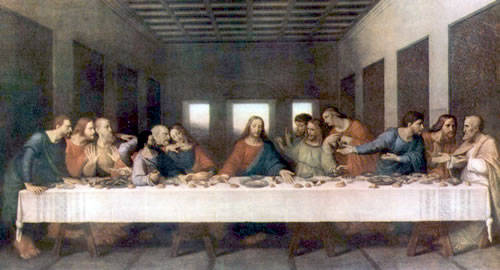Only a great artist like Leonardo da Vinci could create a world-class and immortal painting like The Last Supper. This celebrated painter, with full birth name of Leonardo di ser Piero da Vinci, was born on April 15, 1452 in the town of Vinci, a region in Florence. He was born to unmarried parents; his father, Messer Piero Fruosino di Antonio da Vinci, was a wealthy legal notary while his mother, Caterina, was a humble peasant. His name means that he is Leonardo, the son of Messer Peiro from the town of Vinci. The “ser” in Leonardo’s name implies that his father was a noble man.
Leonardo was a man of great talents. Aside from being one of, if not the greatest painter in history; he was also a scientist, writer, engineer, mathematician, and an inventor, among many other endowments that no ordinary man possessed even during this time. His insatiable curiosity and intensely creative imagination made him not just a renowned painter in history, but even one of the most widely gifted persons ever seen by mankind. Many consider him a genius, with his eclectic views and profound understanding of things. Leonardo was a true representation of a Renaissance artist. He was very instrumental to the evolution of the great Italian Renaissance, a remarkable time in history when creativity was at its best.
The Last Supper painting was one of the major highlights of Leonardo’s career in the world of portrait painting. He made it in response to his employer’s request, Duke Ludovico Sforza of Milan, whom he worked for in almost 18 years. This world renowned 15th century painting was rendered on a dry wall instead of on a wet surface, coated with layers of pitch, gesso, mastic, and tempera to hide the stone wall’s unevenness. However, this technique employed by Leonardo proved to be unsuitable because the painting deteriorated rapidly a few years after its completion.
This religious portrait illustrates the biblical scene of the last supper of Jesus Christ, when Jesus reveals the betrayal of one of His 12 Disciples. It distinctly portrays the diverse reactions of his apostles to the shocking news of betrayal. Three of the apostles shows a surprised reaction; they are Andrew, James (son of Alphaeus), and Bartholomew. Another group of three is that of John, Peter, and Judas Iscariot. Judas is the main character of this group, appearing to be reserved and dazed by the appalling detection of his evil plan. In the painting, Judas is the only one who placed his elbow on the table, this gesture represents his guiltiness. Peter looks really outraged and John seems as if he is going to faint.
Jesus is sitting at the center, with Mary Magdalene on his right side. His position with his arms laid on the table is shaped liked a triangle. There are also three windows behind Him.
Philip, Thomas, and James the Greater are also grouped into three, looking as stunned and upset just like the group of Simon, Matthew, and Jude Thaddeus.
The number 3 is notable in the painting; and this is Leonardo’s way of representing the Christian faith in the Holy Trinity. This unique arrangement in The Last Supper is one of the extraordinary features of the painting.
Leonardo positioned all the characters in The Last Supper to seat on one side of the table only so that their facial expressions can all be seen. It is also very evident that the angle of the room and lighting effects lure towards Jesus, the vanishing point of all the perspective lines in the painting.
Leonardo has incredibly presented this biblical story in such a natural and meaningful manner. The Last Supper painting is so life-like; and up to this time, no other biblical portrait has ever equalled its impeccable pattern.
Author: Shyxter
